

Plant Life Cycles and Garden Design. 9 of 12 in Series: The Essentials of How to Plan a Garden The life cycles of all the plants you choose for your garden play a large part in the garden's overall design.
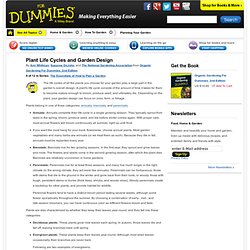
A plant's life cycle consists of the amount of time it takes for them to become mature enough to bloom, produce seed, and ultimately die. Depending on the plant, your garden design can focus on color, form, or foliage. Plants belong in one of three categories: annuals, biennials, and perennials. Annuals: Annuals complete their life cycle in a single growing season. Plants are also characterized by whether they keep their leaves year-round, and they fall into these categories: Deciduous plants: These plants grow new leaves each spring.
Whether a plant drops its leaves is an important consideration in garden design. Gardening Glossary annuals Plants that complete their entire life cycle within one growing season. Biennials A plant that take two growing seasons to complete its life cycle. Bolt cold frame cole crops deadheading humus. Solving Classic Garden Design Problems. 12 of 12 in Series: The Essentials of How to Plan a Garden When you plan your garden you have to start by assessing what you have.
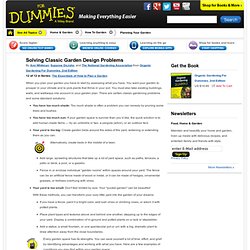
You want your garden to prosper in your climate and to pick plants that thrive in your soil. You must also take existing buildings, walls, and walkways into account in your garden plan. There are certain classic gardening problems and some standard solutions: You have too much shade: Too much shade is often a problem you can remedy by pruning some trees and bushes. Every garden space has its strengths. Sunny days: Bright sunshine is beloved by many plants, especially those with colorful flowers. Gardening Glossary annuals Plants that complete their entire life cycle within one growing season. Biennials A plant that take two growing seasons to complete its life cycle. Bolt When a plant flowers or produces seed prematurely. cold frame A wooden or concrete block box in which you can grow plants or hold dormant during the cold winter months. cole crops deadheading humus. Annual Gardens: How to Combine Plant Shapes and Sizes. 4 of 12 in Series: The Essentials of How to Plan a Garden Annual plants come in myriad sizes, shapes, and forms that enable you to experiment with new garden designs every year.
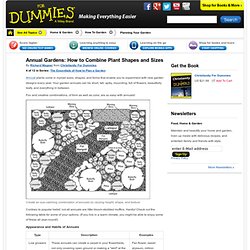
Your garden annuals can be short, tall, spiky, mounding, full of flowers, beautifully leafy, and everything in between. Fun and creative combinations, of form as well as color, are so easy with annuals! Create an eye-catching combination of annuals by varying height, shape, and texture. Contrary to popular belief, not all annuals are little bloom-studded muffins. Here are some good ideas for making annual diversity work in your garden displays: Small in front, medium in the middle, and tall in back: This reliable guideline works because plants don't block one another from view, and the stepping-up effect simply looks great and adds dimension to your flowerbed. Add dimension to a flower bed by planting short annuals in the front and tall ones in the rear. Gardening Glossary. Tips for Designing Perennial Beds and Borders.
5 of 12 in Series: The Essentials of How to Plan a Garden Perennials return each year to provide splashes of color and texture to garden beds and borders.
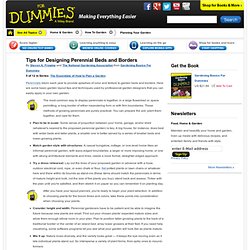
Here are some basic garden layout tips and techniques used by professional garden designers that you can easily apply in your own garden: The most common way to display perennials is together, in a large flowerbed or, space permitting, a long border of either meandering form or with firm boundaries. How to Find Your Hardiness Zone with Maps. 11 of 12 in Series: The Essentials of How to Plan a Garden Hardiness zone maps help you determine which garden plants will thrive where you live.
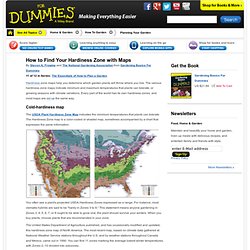
The various hardiness zone maps indicate minimum and maximum temperatures that plants can tolerate, or growing seasons with climate variations. Every part of the world has its own hardiness zones, and most maps are set up the same way. Cold-hardiness map The USDA Plant Hardiness Zone Map indicates the minimum temperatures that plants can tolerate. You often see a plant's projected USDA Hardiness Zones expressed as a range. The United States Department of Agriculture published, and has occasionally modified and updated, this hardiness zone map of North America. Traveler beware: If you buy a plant marked as perennial or hardy in the deep Southern USA or California and you live in a chilly northern region, the plant may be labeled such only for the area where it's sold.
Heat-tolerance map Variable-climate zone map. Garden Planning: How to Assess a Plant's Hardiness. 10 of 12 in Series: The Essentials of How to Plan a Garden When choosing plants for your garden, pay attention to its hardiness, which determines how well it handles climate extremes, such as cold and heat.

Plant catalogs often use the term rather loosely to indicate whether you can expect a particular plant to live in a cold-winter climate, but hardiness really is a measure of a plant's ability to survive all the aspects of a particular climate. Many factors influence a plant's cold-hardiness: Genetics: The genetic adaptability of plants to specific climates and soils is called provenance.
Climatic factors that influence plant survival include the following: Duration of winter: Genetic programming signals some plants to begin flowering and growing after a particular number of hours of cold temperatures followed by warm temperatures. Heat tolerance is a common limiting factor for plants, and in many parts of the country, this factor is the primary concern. Gardening Methods.
Planting Vegetables from Seed and Seedling. By The National Gardening Association, Bob Beckstrom, Karan Davis Cutler, Kathleen Fisher, Phillip Giroux, Judy Glattstein, Mike MacCaskey, Bill Marken, Charlie Nardozzi, Sally Roth, Marcia Tatroe, Lance Walheim, and Ann Whitmanfrom Gardening All-in-One For Dummies You can plant vegetable seeds indoors or outdoors.
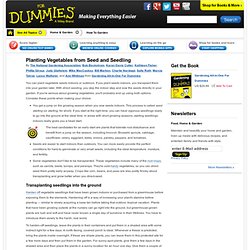
If you plant seeds indoors, you transplant them into your garden later. With direct seeding, you skip the indoor step and sow the seeds directly in your garden. If you're serious about growing vegetables, you'll probably end up using both options. Consider these points when making your choice: You get a jump on the growing season when you sow seeds indoors. Transplanting seedlings into the ground Harden off vegetable seedlings that have been grown indoors or purchased from a greenhouse before exposing them to the elements.
To harden-off seedlings, leave the plants in their containers and put them in a shaded area with some indirect light for a few days. Gardening Glossary bolt pH. Planting Vegetables from Seed and Seedling.